
Cirkit Designer
Your all-in-one circuit design IDE
Home /
Component Documentation
How to Use L298N DC motor driver: Examples, Pinouts, and Specs
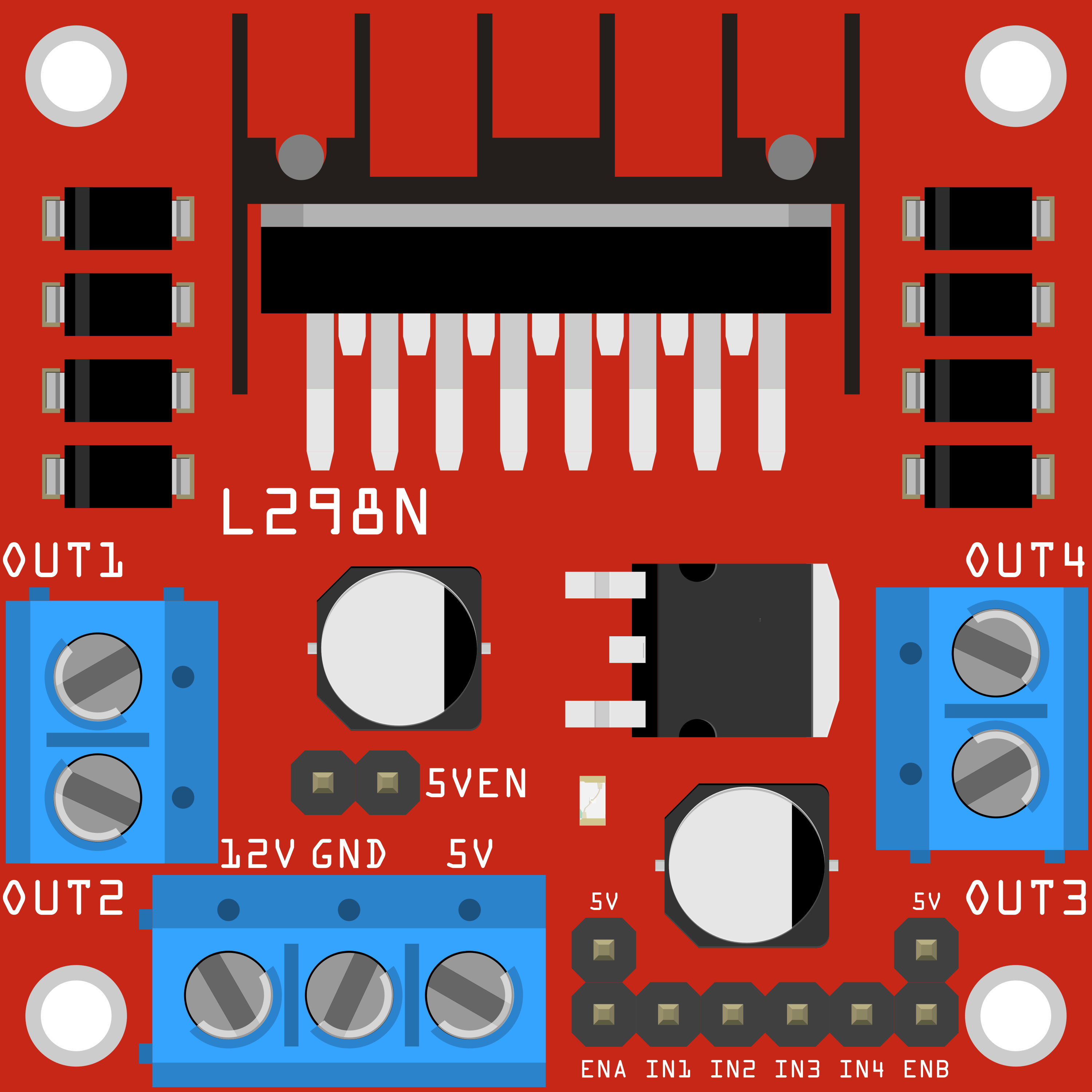
 Design with L298N DC motor driver in Cirkit Designer
Design with L298N DC motor driver in Cirkit DesignerIntroduction
The L298N DC Motor Driver Module is a robust and versatile component designed to control the speed and direction of two DC motors. It features a dual H-bridge configuration, allowing it to handle high current and voltage, making it ideal for various robotics and automation projects. This module is widely used in applications such as robotic arms, conveyor belts, and automated vehicles.
Explore Projects Built with L298N DC motor driver
L298N DC Motor Driver Controlled DC Motor System
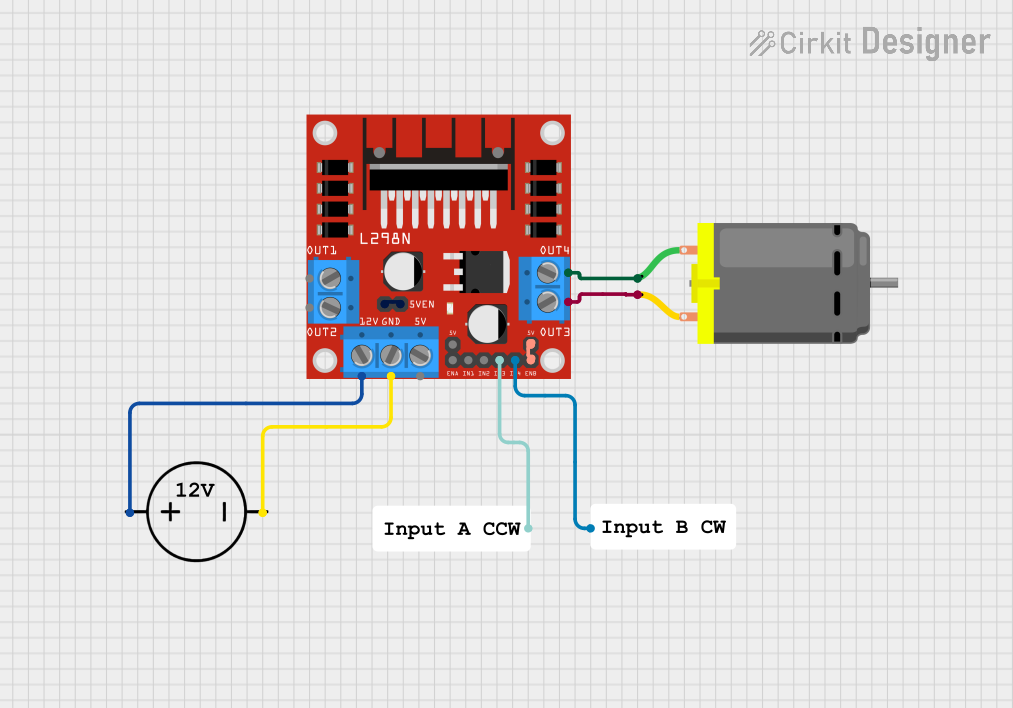
This circuit is designed to control a DC motor using an L298N motor driver module. The motor driver is powered by a DC power source and interfaces with the motor through its output pins, while resistors are used to manage the input signals to the driver.
 Open Project in Cirkit Designer
Open Project in Cirkit DesignerWi-Fi Controlled Quad DC Motor Driver System
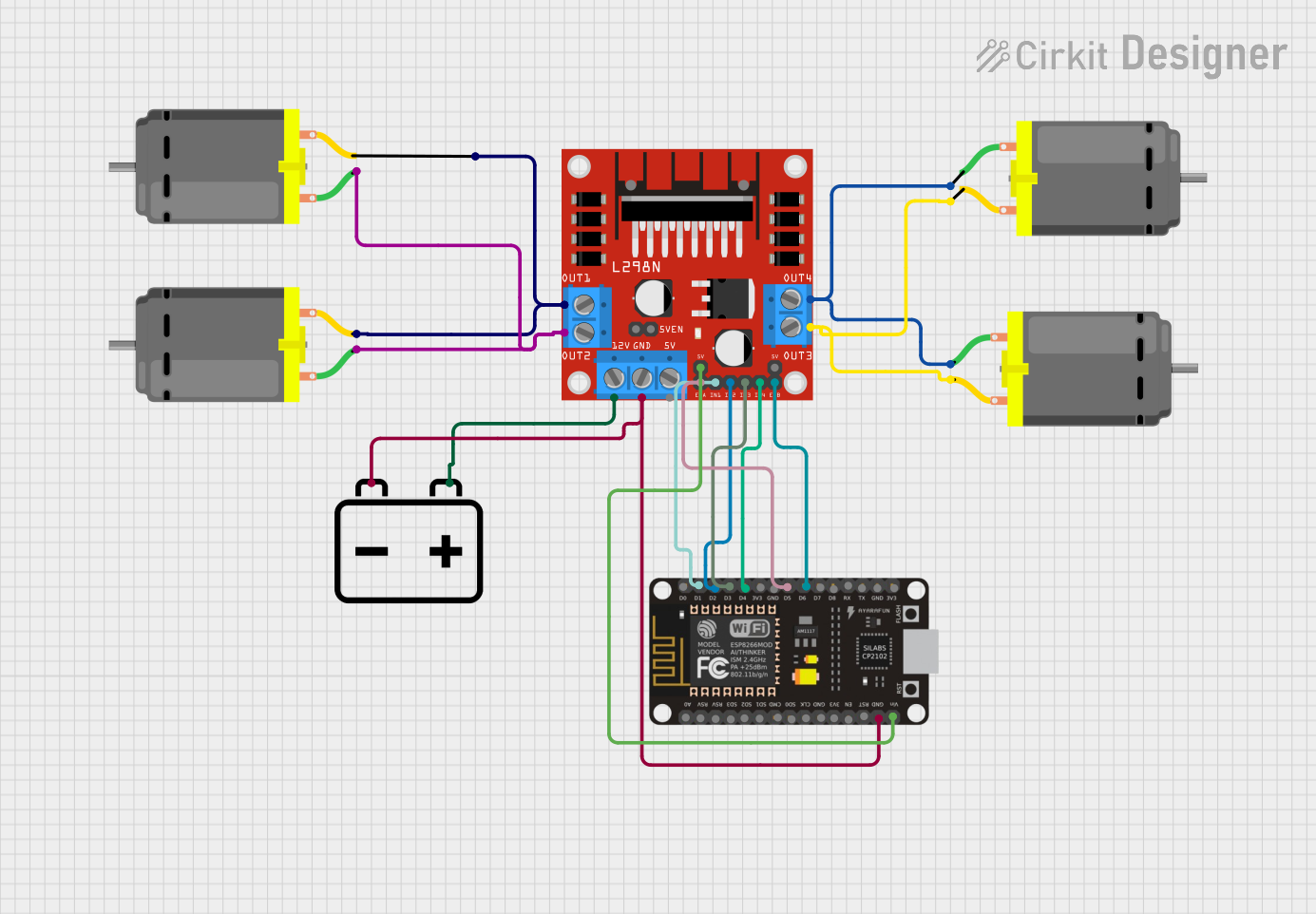
This circuit is designed to control four DC motors using an L298N motor driver module, which is interfaced with an ESP8266 NodeMCU microcontroller. The NodeMCU's digital pins (D1-D6) are connected to the input pins of the L298N to control the speed and direction of the motors. A 12V battery provides power to the motors through the motor driver, and also powers the NodeMCU through a voltage regulator on the L298N.
 Open Project in Cirkit Designer
Open Project in Cirkit DesignerArduino and L298N Motor Driver Controlled DC Motor System
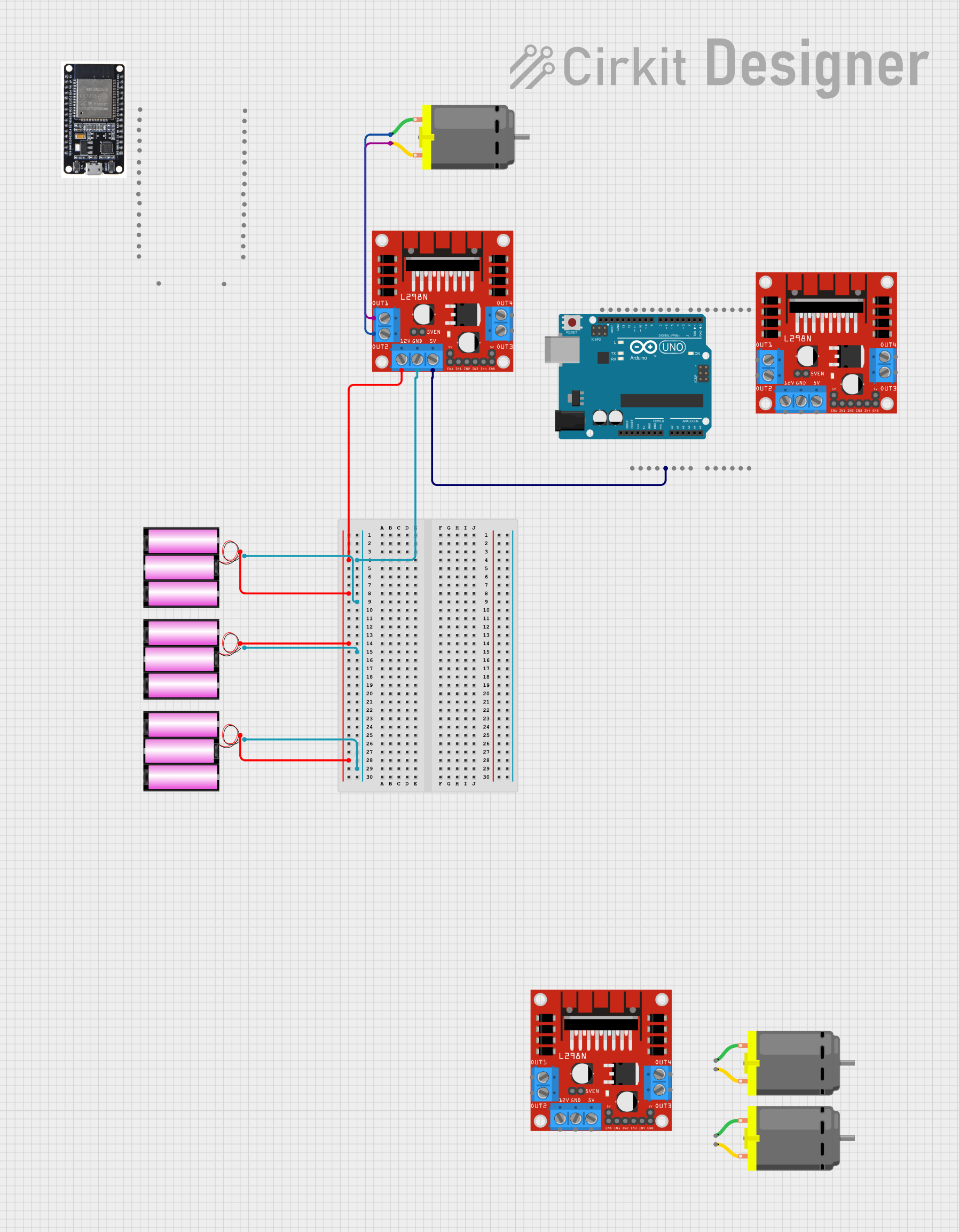
This circuit controls a DC motor using an L298N motor driver module, powered by three 12V batteries. An Arduino UNO is used to provide 5V power to the motor driver and can be programmed to control the motor's operation.
 Open Project in Cirkit Designer
Open Project in Cirkit DesignerArduino-Controlled Fire Detection and GSM Notification System
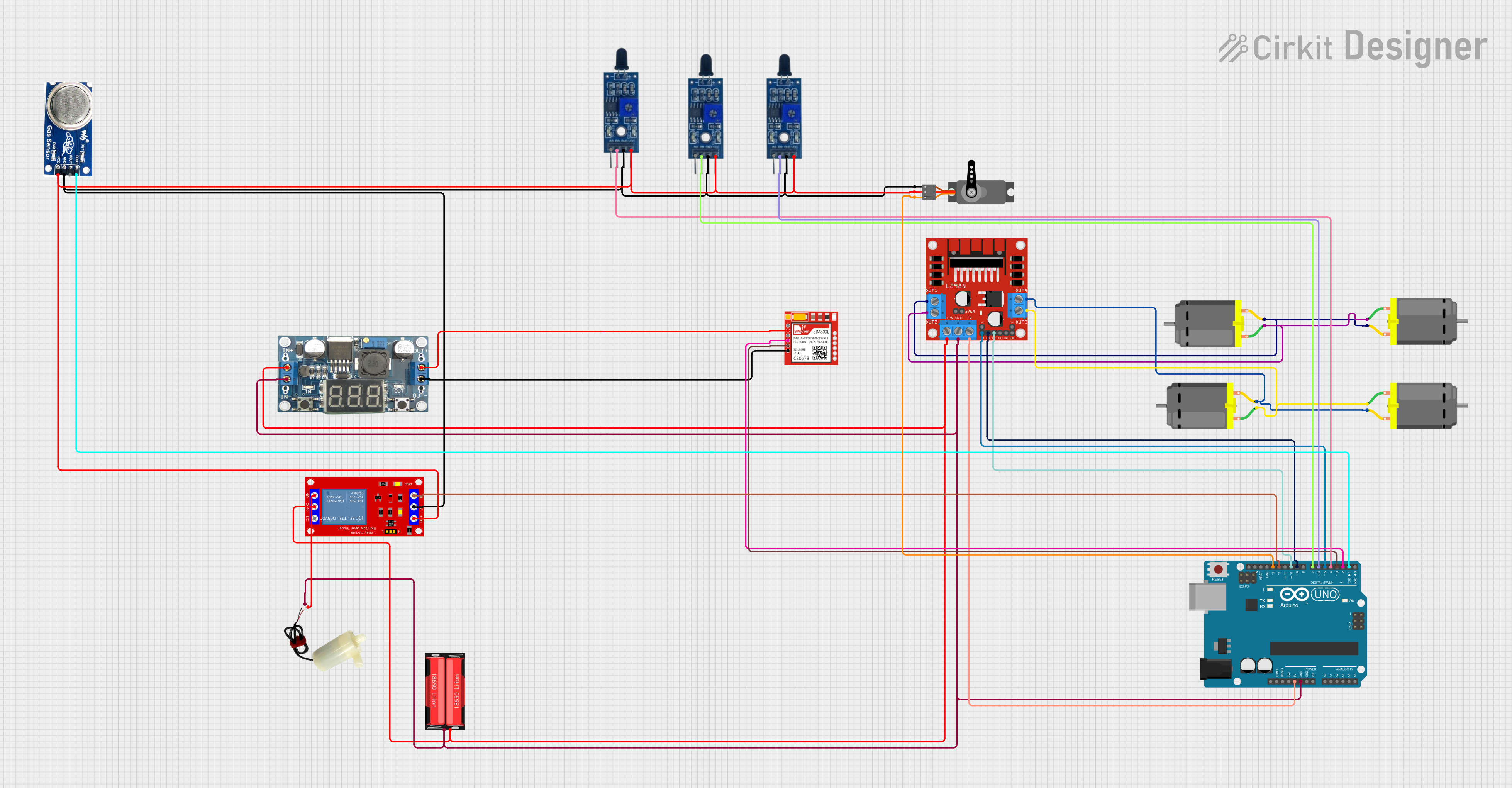
This circuit is designed to control multiple DC motors using an L298N motor driver, which is interfaced with an Arduino UNO microcontroller. The Arduino controls the direction and speed of the motors, as well as a servo motor, and can activate a water pump via a relay module. Additionally, the circuit includes flame and smoke sensors for safety monitoring, and a SIM800L module for potential communication capabilities.
 Open Project in Cirkit Designer
Open Project in Cirkit DesignerExplore Projects Built with L298N DC motor driver

L298N DC Motor Driver Controlled DC Motor System
This circuit is designed to control a DC motor using an L298N motor driver module. The motor driver is powered by a DC power source and interfaces with the motor through its output pins, while resistors are used to manage the input signals to the driver.
 Open Project in Cirkit Designer
Open Project in Cirkit Designer
Wi-Fi Controlled Quad DC Motor Driver System
This circuit is designed to control four DC motors using an L298N motor driver module, which is interfaced with an ESP8266 NodeMCU microcontroller. The NodeMCU's digital pins (D1-D6) are connected to the input pins of the L298N to control the speed and direction of the motors. A 12V battery provides power to the motors through the motor driver, and also powers the NodeMCU through a voltage regulator on the L298N.
 Open Project in Cirkit Designer
Open Project in Cirkit Designer
Arduino and L298N Motor Driver Controlled DC Motor System
This circuit controls a DC motor using an L298N motor driver module, powered by three 12V batteries. An Arduino UNO is used to provide 5V power to the motor driver and can be programmed to control the motor's operation.
 Open Project in Cirkit Designer
Open Project in Cirkit Designer
Arduino-Controlled Fire Detection and GSM Notification System
This circuit is designed to control multiple DC motors using an L298N motor driver, which is interfaced with an Arduino UNO microcontroller. The Arduino controls the direction and speed of the motors, as well as a servo motor, and can activate a water pump via a relay module. Additionally, the circuit includes flame and smoke sensors for safety monitoring, and a SIM800L module for potential communication capabilities.
 Open Project in Cirkit Designer
Open Project in Cirkit DesignerTechnical Specifications
Key Technical Details
| Parameter | Value |
|---|---|
| Operating Voltage | 5V to 35V |
| Output Current | 2A per channel (max 3A peak) |
| Power Dissipation | 25W |
| Control Logic | Standard TTL logic levels |
| Dimensions | 43mm x 43mm x 27mm |
Pin Configuration and Descriptions
| Pin Number | Pin Name | Description |
|---|---|---|
| 1 | ENA | Enable pin for Motor A (active high) |
| 2 | IN1 | Input 1 for Motor A |
| 3 | IN2 | Input 2 for Motor A |
| 4 | OUT1 | Output 1 for Motor A |
| 5 | OUT2 | Output 2 for Motor A |
| 6 | GND | Ground |
| 7 | VCC | Supply voltage for the motor (5V to 35V) |
| 8 | ENB | Enable pin for Motor B (active high) |
| 9 | IN3 | Input 1 for Motor B |
| 10 | IN4 | Input 2 for Motor B |
| 11 | OUT3 | Output 1 for Motor B |
| 12 | OUT4 | Output 2 for Motor B |
| 13 | 5V | 5V logic supply (optional, if not using onboard 5V regulator) |
| 14 | GND | Ground |
Usage Instructions
How to Use the Component in a Circuit
Power Supply:
- Connect the VCC pin to a power source (5V to 35V) suitable for your motors.
- Connect the GND pin to the ground of the power source.
Motor Connections:
- Connect the motor terminals to OUT1 and OUT2 for Motor A.
- Connect the motor terminals to OUT3 and OUT4 for Motor B.
Control Pins:
- Connect ENA to a PWM-capable pin on your microcontroller to control the speed of Motor A.
- Connect ENB to a PWM-capable pin on your microcontroller to control the speed of Motor B.
- Connect IN1 and IN2 to digital pins on your microcontroller to control the direction of Motor A.
- Connect IN3 and IN4 to digital pins on your microcontroller to control the direction of Motor B.
Important Considerations and Best Practices
- Ensure that the power supply voltage matches the voltage rating of your motors.
- Use appropriate heat sinks if you are operating at high currents to prevent overheating.
- Double-check all connections before powering up the module to avoid short circuits.
- Use appropriate decoupling capacitors to filter out noise from the power supply.
Example Code for Arduino UNO
// Define motor control pins
const int ENA = 9; // PWM pin for Motor A speed control
const int IN1 = 8; // Direction control pin for Motor A
const int IN2 = 7; // Direction control pin for Motor A
const int ENB = 10; // PWM pin for Motor B speed control
const int IN3 = 6; // Direction control pin for Motor B
const int IN4 = 5; // Direction control pin for Motor B
void setup() {
// Set all the motor control pins as outputs
pinMode(ENA, OUTPUT);
pinMode(IN1, OUTPUT);
pinMode(IN2, OUTPUT);
pinMode(ENB, OUTPUT);
pinMode(IN3, OUTPUT);
pinMode(IN4, OUTPUT);
}
void loop() {
// Example: Rotate Motor A forward at half speed
digitalWrite(IN1, HIGH);
digitalWrite(IN2, LOW);
analogWrite(ENA, 128); // 128 is 50% duty cycle
// Example: Rotate Motor B backward at full speed
digitalWrite(IN3, LOW);
digitalWrite(IN4, HIGH);
analogWrite(ENB, 255); // 255 is 100% duty cycle
delay(2000); // Run motors for 2 seconds
// Stop both motors
analogWrite(ENA, 0);
analogWrite(ENB, 0);
delay(2000); // Wait for 2 seconds before repeating
}
Troubleshooting and FAQs
Common Issues Users Might Face
Motors Not Running:
- Check if the power supply is connected and providing the correct voltage.
- Ensure that the ENA and ENB pins are receiving PWM signals.
- Verify that the IN1, IN2, IN3, and IN4 pins are correctly set for the desired direction.
Overheating:
- Ensure that the current drawn by the motors does not exceed the module's rating.
- Use heat sinks or cooling fans if necessary.
Erratic Motor Behavior:
- Check for loose connections or short circuits.
- Use decoupling capacitors to filter out noise from the power supply.
Solutions and Tips for Troubleshooting
- Power Supply Issues: Use a multimeter to check the voltage at the VCC and GND pins.
- Signal Issues: Use an oscilloscope to verify the PWM signals at the ENA and ENB pins.
- Connection Issues: Double-check all wiring and ensure that there are no loose connections.
By following this documentation, users should be able to effectively utilize the L298N DC Motor Driver Module in their projects, ensuring reliable and efficient motor control.